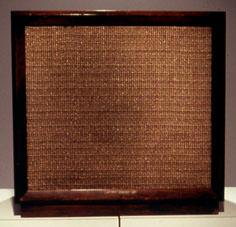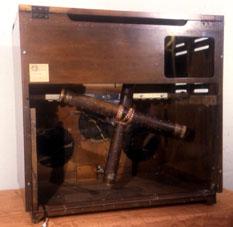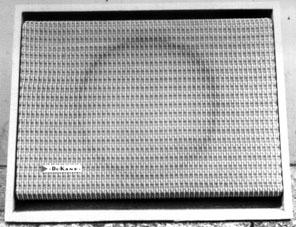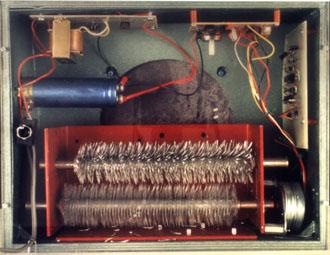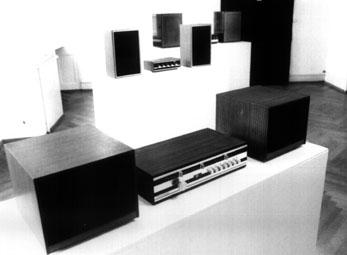Music From Nowhere
1st exhibition: Generator Sound Art, New York, 1990
In the Music From Nowhere series a variety of loudspeaker cabinets are transformed into acoustic sound-producing devices. The actual speakers are removed from inside the speaker cabinets and the cabinet interiors are refitted with mechanical-acoustic sound-producing systems. All devices are automated so that they work independently for an unlimited length of time. These may be modified water fountains, mechanical vibrators, or logic and motor-driven systems that articulate acoustic sounds. Each system is designed with built-in mechanical variables to produce variation or indeterminacy within the sound, thus helping to create the illusion that one is listening to a recording being broadcast through the given speaker cabinet. Each speaker cabinet has a plexiglas backing so that the viewer can see inside the box. These fake loudspeakers are exhibited together in a room so that a form of ‘real’ musique concrete is achieved.
The loudspeaker can be regarded as a profane oracle. It not only gives us our daily music, but more potently, it can define a lifestyle for the user: punk, heavy metal devotee, hippie, opera buff.
There are many packaging formats for the sources of sounds we hear through loudspeakers: magnetic tape, vinyl disk, digital chip, digital disk, digital tape. All of these packaged sounds are given life when broadcast through a loudspeaker. However, the system we depend upon to give our music its life actually gives us something artificial: loudspeaker music is a pre-fabricated simulation of reality. For instance, the so-called ‘bands’ we listen to in pop music recordings do not play together, they over-dub one track at a time to create an illusion of ensemble. And the resulting music is then transferred many rooms away by electrical impulses far removed from the reality of say, a vibrating string.
In the Music From Nowhere series I have removed the loudspeakers from the loudspeaker cabinets and replaced them with real, acoustically-produced sounds to create a kind of ‘fake’ loudspeaker. In spite of this, one still considers these objects to be ‘speakers’; what else could you call them?
When confronted with one of these speakers I have found that almost all viewers assume that they are listening to recorded or amplified sound. But these are packages of live, natural, environmental sounds. When one or more of these speakers share the same acoustical space they can form a composition not unlike pieces by the composers of the musique concrete movement. And as with recorded sound, these pieces are archives of sound that will change only when the original sound is removed from the cabinet (or erased from the medium). If unaltered, these sounds will remain the same, or perhaps degenerate over time as most recorded media will. In this way, these pieces can be considered analogous to other packaged sound media and in fact can be considered a new packaging format for sound that is simultaneously lo- and hi-fi.
Each of these loudspeaker cabinets has a secret history that is their own. In past lives they may have broadcast the same music or radio programs at the same time, thus linking to each other through the global stream of electromagnetic communication. They have been oracles of fantasy for their listeners. Each sound that I have placed in these cabinets alludes to the past audio lives of the speakers that once occupied these packages. Perhaps for a fleeting moment some years ago, simulations of these very sounds were broadcast through these cabinets.
©Gordon Monahan 1989





